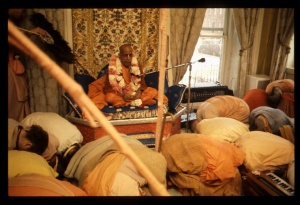SB 3.1.17

A.C. Bhaktivedanta Swami Prabhupada
TEXT 17
- sa nirgataḥ kaurava-puṇya-labdho
- gajāhvayāt tīrtha-padaḥ padāni
- anvākramat puṇya-cikīrṣayorvyām
- adhiṣṭhito yāni sahasra-mūrtiḥ
SYNONYMS
saḥ — he (Vidura); nirgataḥ — after having quit; kaurava — the Kuru dynasty; puṇya — piety; labdhaḥ — so achieved; gaja-āhvayāt — from Hastināpura; tīrtha-padaḥ — of the Supreme Lord; padāni — pilgrimages; anvākramat — took shelter; puṇya — piety; cikīrṣayā — desiring so; urvyām — on the Earth; adhiṣṭhitaḥ — situated; yāni — all those; sahasra — thousands; mūrtiḥ — forms.
TRANSLATION
By his piety, Vidura achieved the advantages of the pious Kauravas. After leaving Hastināpura, he took shelter of many places of pilgrimages, which are the Lord's lotus feet. With a desire to gain a high order of pious life, he traveled to holy places where thousands of transcendental forms of the Lord are situated.
PURPORT
Vidura was undoubtedly a highly elevated and pious soul, otherwise he would not have taken his birth in the Kaurava family. To have high parentage, to possess wealth, to be highly learned and to have great personal beauty are all due to past pious acts. But such pious possessions are not sufficient for obtaining the grace of the Lord and being engaged in His transcendental loving service. Vidura considered himself less pious, and therefore he decided to travel to all the great places of pilgrimage in the world in order to achieve greater piety and advance nearer to the Lord. At that time, Lord Kṛṣṇa was personally present in the world, and Vidura could have at once approached Him directly, but he did not do so because he was not sufficiently freed from sin. One cannot be one hundred percent devoted to the Lord unless and until he is completely free from all effects of sin. Vidura was conscious that by the association of the diplomatic Dhṛtarāṣṭra and Duryodhana he had lost his piety and was therefore not fit to associate at once with the Lord. In Bhagavad-gītā (BG 7.28) this is confirmed in the following verse:
- yeṣāṁ tv anta-gataṁ pāpaṁ
- janānāṁ puṇya-karmaṇām
- te dvandva-moha-nirmuktā
- bhajante māṁ dṛḍha-vratāḥ
Persons who are sinful asuras like Kaṁsa and Jarāsandha cannot think of Lord Kṛṣṇa as the Supreme Personality of Godhead, the Absolute Truth. Only those who are pure devotees, those who follow the regulative principles of religious life as prescribed in the scriptures, are able to engage themselves in karma-yoga and then jñāna-yoga and thereafter, by pure meditation, can understand pure consciousness. When God consciousness is developed, one can take advantage of the association of pure devotees. Syān mahat-sevayā viprāḥ puṇya-tīrtha-niṣevaṇāt: one is able to associate with the Lord even during the existence of this life.
Places of pilgrimages are meant for eradicating the sins of the pilgrims, and they are distributed all over the universe just to give facility to all concerned for attaining pure existence and God realization. One should not be satisfied, however, merely by visiting the places of pilgrimage and performing one's prescribed duties; he should be eager to meet the great souls who are already there, engaged in the service of the Lord. In each and every place of pilgrimage, the Lord is present in His various transcendental forms.
These forms are called arcā-mūrtis, or forms of the Lord which can be easily appreciated by the common man. The Lord is transcendental to our mundane senses. He cannot be seen with our present eyes, nor can He be heard with our present ears. To the degree that we have entered into the service of the Lord or to the proportion to which our lives are freed from sins, we can perceive the Lord. But even though we are not free from sins, the Lord is kind enough to allow us the facility of seeing Him in His arcā-mūrtis in the temple. The Lord is all-powerful, and therefore He is able to accept our service by presentation of His arcā form. No one, therefore, should foolishly think the arcā in the temple to be an idol. Such an arcā-mūrti is not an idol but the Lord Himself, and to the proportion to which one is free from sins, he is able to know the significance of the arcā-mūrti. The guidance of a pure devotee is therefore always required.
In the land of Bhāratavarṣa there are many hundreds and thousands of places of pilgrimage distributed all over the country, and by traditional practice the common man visits such holy places during all seasons of the year. Some of the arcā representations of the Lord situated in different places of pilgrimage are mentioned herewith. The Lord is present at Mathurā (the birthplace of Lord Kṛṣṇa) as Adi-keśava; the Lord is present at Purī (Orissa) as Lord Jagannātha (also known as Puruṣottama); He is present at Allahabad (Prayāga) as Bindu-mādhava; at Mandara Hill He is present as Madhusūdana. In the Ānandāraṇya, He is known as Vāsudeva, Padmanābha and Janārdana; at Viṣṇukāñcī, He is known as Viṣṇu; and at Māyāpura, He is known as Hari. There are millions and billions of such arcā forms of the Lord distributed all over the universe. All these arcā-mūrtis are summarized in the Caitanya-caritāmṛta in the following words:
- sarvatra prakāśa tāṅra—bhakte sukha dite
- jagatera adharma nāśi' dharma sthāpite
"The Lord has so distributed Himself all over the universe just to give pleasure to the devotees, to give the common man facility to eradicate his sins, and to establish religious principles in the world."